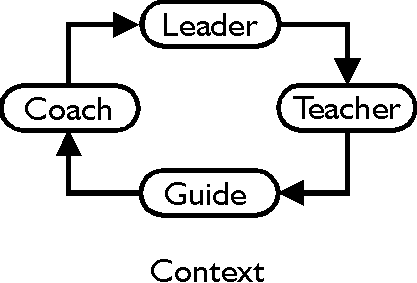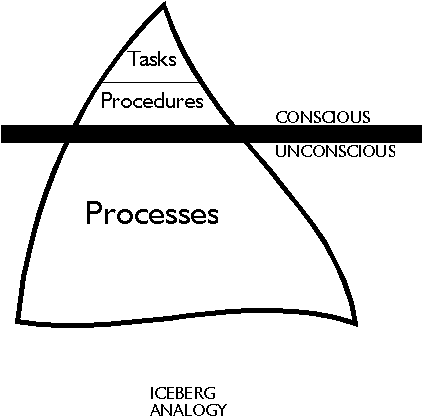|
G . O . R . I . L . L . A . |
| home |
|
|
|
The Art of Facilitation Introduction. Also well documented is the realisation that managers have to add to their already considerable repertoire of skills in order to manage the new empowered team effectively. These additions to the repertoire come under the heading of facilitation skills. The dictionary definition of a facilitator is: one who makes easier; one who assists the progress of another. In our work with organisations who are making the transition to team based working and with managers who wish to learn how to facilitate, we have identified and defined a core set of conditions which are fundamental to the process of facilitating teamwork. The competency of a facilitator is measured by their ability to create and maintain these core conditions. The Role of the Facilitator.
In the role of teacher, the facilitator teaches by showing how things are done, by example, by providing relevant and meaningful information, and by instruction where appropriate. The underlying intention here is to teach staff how to learn for themselves using their own experience as a benchmark. In the role of guide, the facilitator provides wise counsel and appropriate advice; the underlying intention here is to enable staff to become able to guide themselves, and to welcome responsibility. In the role of coach, the facilitator provides direct instruction to fine tune individual performance; the underlying intention is to set high standards and to enable staff to become self managing. In the role of leader, the facilitator leads by example, exemplifies the values of the organisation and the team, and is a model of good team practice. The intention is to promote the ideal teamworking environment where creativity and initiative thrive. The manager must choose which role to use at any given time and must then make a further decision about how to facilitate within the chosen role, for this there is a range of three options.
In Hierarchical Mode, the manager is in absolute control and everybody knows and understands this. Hierarchically managed teams have a clear [explicit], or unstated [implicit] command and control system; there is commonly one right way of doing things, usually the manager's. The manager makes all decisions and decides on the correct course of action. In this mode the manager may not be using the expertise contained within the team, may be unable or unwilling to allow team members to take any responsibility, and can therefore stifle initiative. In co-operative mode the manager and the team make decisions together. Essentially they meet to make decisions as peers, everyone has an equal say, and responsibility is shared and owned by all team members. Many managers say they manage co-operatively, but when it comes to the crunch they make the decisions themselves. When this happens the manager has moved back into hierarchical mode. There will of course be occasions when this is absolutely necessary, but many of these 'flips' back into hierarchy are driven by the manager's anxiety rather than need. Co-operative mode makes full use of the manager's and the team's expertise. In autonomous mode, the manager gives authority and responsibility to the team to make decisions, and agrees to abide by the decisions the team makes. This mode makes full use of the expertise contained within the team, implies a high level of trust, and demands maturity and responsibility from manager and team. In autonomous mode the manager places trust in the expertise contained within the team. There is no 'right mode'. No mode has greater priority than any other. The operating mode is dictated by situation and context. The effective manager is able to move between all three modes effortlessly, depending on the needs of the situation. Although there will always be situations which demand hierarchical management because of the nature of the job or some current crisis, effective teams are managed hierarchically only when hierarchy is appropriate. To facilitate effective teamwork the manager must be clear about his or her intention, choose the appropriate role, option and operating mode. When the manager chooses wrongly, either by intention, or because of lack of proper training and experience, their practice has degenerated and effective teamwork is less likely to occur. Creating the conditions where teamwork takes place.
If we use the analogy of an iceberg, then task and procedures are the part of the iceberg which is visible, processess are the part of the iceberg which is under the surface and therefore less visible. An understanding of processes is crucial to teamwork, yet they are probably the least understood. The following sections focus on important aspects of process. The competent facilitator helps the team to identify and work with these by creating the right conditions within the team. This is a key issue for facilitators, when these conditions are desired but do not occur, responsibility for at least part of the problem lies with the facilitator. The conditions for effective teamwork. Reflect on experience. You as manager must be able to self reflect before you can facilitate reflection and learning in your team. In order for your team to learn anything, including how to function as a team, it has to have experience upon which to reflect and, it has to set aside time to engage in reflection. Time for reflection is one of the most crucial conditions for effective teamwork. There are many useful models of reflective practice, one which we use regularly, is the experiential learning cycle.
It begins by focusing on experience and asks the question, what did I just do? This is followed by, what did the experience mean for me? The final question is, what must I do next in order to extend my learning into action? Create the conditions for learning by setting regular time aside for reflection. Recognise the needs of team members. A team is a micro-society. All team members need to feel that they belong to the team, and at least some aspects of belonging are about 'social' needs; note that this is not the same as socialising, although socialising can sometimes help to meet 'social' needs. Social needs include the need to be seen and heard as a human being and a colleague, to be treated with basic respect, to give and receive support, as well as to fulfill the tasks of the job. Managers need to recognise that part of the implicit reward of being a team member is the fulfilment of these and other social needs. Increased motivation, commitment and loyalty, to the team and to the organisation, are the benefits which accrue when these needs are met. Prove or disprove this for yourself by asking colleagues and team members. Create a climate of co-operation. The process function of a team is to be 'greater than the sum of its parts'. This implicitly acknowledges that working in teams offers benefits to the organisation and to each individual member of the team, which could not be obtained if the individuals were working in isolation or were in competition with one another. Ask yourself if there is inappropriate competition within your team. If there is, identify ways in which this competition works against the team objective. With the team, identify areas where co-operation would improve performance and devise ways to achieve this. Welcome conflict and work towards resolution. Value communication and dialogue. Share ownership of the vision. Work hard to create trust. Work in the open. On going learning and development. Facilitation. The ability to facilitate is an art. It demands high levels of awareness from those who wish to facilitate. The competency of the manager as facilitator is measured in the ability to do all of the above and to facilitate others to do the same. Patrick Young can be contacted at, patyoung@pncl.co.uk References and inspiration:
Except where otherwise indicated, these screens are maintained and © 1995,1996,1997,1998,1999,2000, 2002, 2003,2004 Denis Postle. All rights reserved. Last updated 12th August 2004 |



